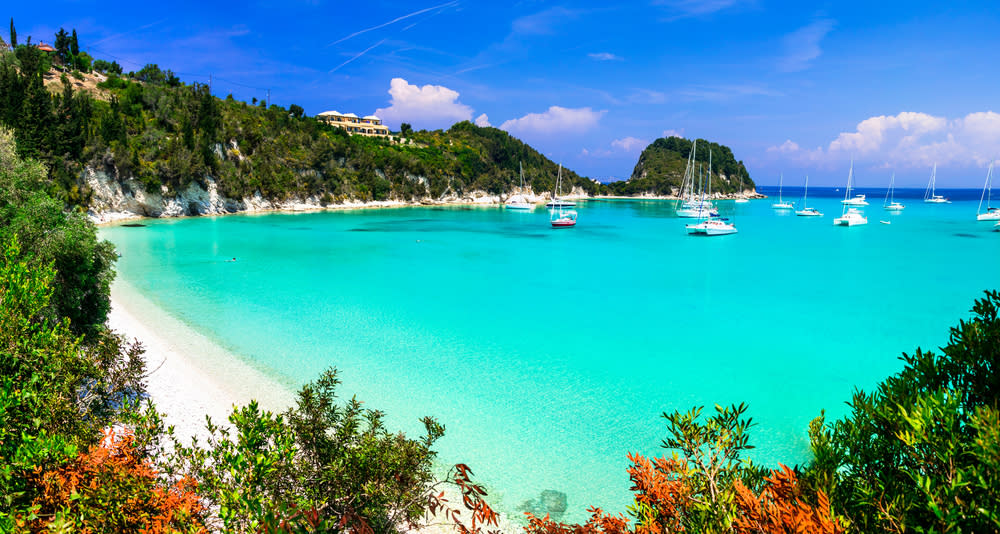More from Paxos
Main Menu
- 00:00
- 06:00
- 12:00
- 18:00
- 23:00
Paxos : Next 24-Hour Weather
Today - 9th May 2025
Sunrise 06:32
Sunset 20:40
Tomorrow - 10th May 2025
Sunrise 06:32
Sunset 20:40
Holiday Weather Now
Sorted by popularity:
Updated at 08:00 GMT
-
Temp feels like25°C77°F
-
Length of day14h 08m
-
Pressure29" (1011 hpa)
-
Visibility10 km (6miles)
-
Wind speed12 km/h
Sunrise 06:32
Sunset 20:40
-
Temp feels like:
25ºC (77 ºF)
-
Length of day:
14h 08m
-
Pressure:
29" (1011 hpa)
-
Visibility:
6 miles (10 km)
-
Wind speed:
12 km/h
Paxos benefits from a mild Mediterranean climate with long, hot summers that are usually slightly cooler than in the rest of Greece and short, mild, rainy winters. It is about fourteen kilometres from Corfu (Kerkyra) and is one of the Ionian Islands sitting off the west coast of mainland Greece in the Ionian Sea. The Ionian Islands receive considerably more rain than the rest of Greece but their summers are still pleasantly dry.
Spring on Paxos lasts from March till mid-May. From March to April the average high temperature rises from 16°C to 19°C. Night times remain cool, usually below 10°C. The chance of rain still lingers but gradually decreases, and the sea begins to warm up. As early as May temperatures rise into the mid 20s though at night it still gets down to 13°C. This is seen as a great time to visit Paxos for walking and painting holidays. With the sun coming out for around nine hours a day by May, the lush landscape can be enjoyed in mild temperatures.
Summer, from June till September, sees sought-after long, hot days. Temperatures get up into the high 20s, peaking at 31°C in July and August. From the end of May the heat sets in and the sun comes out for over ten luxurious hours each day. The clear sea is perfect for swimming â" often a much-needed break from the heat. In the afternoons a refreshing breeze sweeps in from the sea then retreats again, leaving you to lounge in the warm evenings and enjoy Mediterranean food into the night. Staying up near 20°C, sleeping on peak season nights can be a sticky affair, but a fan or air-conditioning would provide relief.
In autumn the weather stays warm but becomes rainier and less predictable. October and November still see daytime temperatures around the 20s; the sea remains warm enough for swimming and the sun still comes out for around five hours a day. Visiting Paxos in October is smart choice; there are fewer tourists, the days do not reach the scorching summer highs and the nights get pleasantly cool. Showers quite frequently interrupt the sunny days but rarely last for long. However, rainfall increases steadily from the start of the season and November is Paxosâ wettest month.
In the winter months from December till February Paxos is not easily accessible and the wet weather puts off prospective visitors. In the day time temperatures sit around 15°C while at night it falls to around 6°C, sometimes getting much colder. It rains regularly though the sun still manages to come out for around four or five hours a day.
The result of the Ionian Islandsâ wetter and milder weather is a completely different landscape. Much of Greece is known for its arid, barren hills while Paxos, and the rest of the Ionian Islands, are green. They are covered in thick vegetation and their fertile soil allows successful farming; olive oil production was once the Ionian Islandsâ greatest source of income. It is now tourism, of course. While Paxos is wetter, water is paradoxically a scarce commodity as there is no source of fresh water on the island. Most houses have âsternasâ, which are huge water tanks, to collect the winter rains.

















